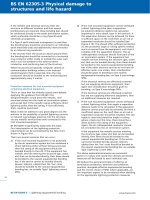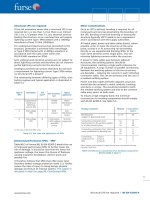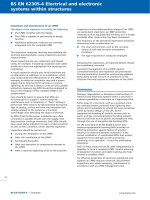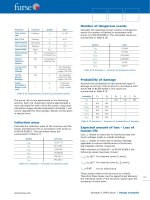Bsi bs en 01195 1998
Bạn đang xem bản rút gọn của tài liệu. Xem và tải ngay bản đầy đủ của tài liệu tại đây (246.72 KB, 14 trang )
BRITISH STANDARD
Timber structures Ð
Test methods Ð
Performance of
structural floor decking
The European Standard EN 1195 : 1997 has the status of a
British Standard
ICS 91.060.30; 91.080.20
NO COPYING WITHOUT BSI PERMISSION EXCEPT AS PERMITTED BY COPYRIGHT LAW
| BS EN
|
|
| 1195 : 1998
|
| Incorporating
|
| Amendment No. 1
|
|
|
|
|
|
|
|
|
|
|
|
|
|
|
|
|
|
|
|
|
|
|
|
|
|
|
|
|
|
|
|
|
|
|
|
|
|
|
|
|
|
|
|
|
|
|
|
|
|
|
|
|
|
|
|
|
|
|
|
|
|
|
|
|
|
|
|
|
|
|
|
|
|
|
|
|
|
|
|
|
|
|
|
|
|
|
|
|
|
|
|
|
|
|
|
|
|
|
|
|
|
|
|
|
|
|
|
|
|
|
|
|
|
|
|
|
|
|
|
|
BS EN 1195 : 1998
National foreword
This British Standard is the English language version of EN 1195 : 1997.
The UK participation in its preparation was entrusted by Technical Committee
B/518, Structural timber, to Subcommittee B/518/1, Test methods, which has the
responsibility to:
± aid enquirers to understand the text;
± present to the responsible European committee any enquiries on the
interpretation, or proposals for change, and keep the UK interests informed;
± monitor related international and European developments and promulgate
them in the UK.
A list of organizations represented on this committee can be obtained on request to
its secretary.
Cross-references
The British Standards which implement international or European publications
referred to in this document may be found in the BSI Standards Catalogue under the
section entitled `International Standards Correspondence Index', or by using the
`Find' facility of the BSI Standards Electronic Catalogue.
Compliance with a British Standard does not of itself confer immunity
from legal obligations.
This British Standard, having
been prepared under the
direction of the Sector Board for
Building and Civil Engineering,
was published under the
authority of the Standards Board
and comes into effect on
15 February 1998
BSI 1998
ISBN 0 580 28998 2
Amendments issued since publication
Amd. No.
Date
Text affected
9976
May 1998
Indicated by a sideline in the margin
EN 1195
EUROPEAN STANDARD
NORME EUROPÊENNE
EUROPẰISCHE NORM
October 1997
ICS 91.060.30; 91.080.20
Descriptors: Timber construction, wooden floors, tests, impact tests, static tests, loadings, stiffness tests, comparative tests, test results
English version
Timber structures Ð Test methods Ð
Performance of structural floor decking
Structures en bois Ð MeÂthodes d'essais Ð
Comportement des planchers structuraux
Holzbauwerke Ð PruÈfverfahren Ð Tragverhalten
tragender FuûbodenbelaÈge
This European Standard was approved by CEN on 1997-10-02.
CEN members are bound to comply with the CEN/CENELEC Internal Regulations
which stipulate the conditions for giving this European Standard the status of a
national standard without any alteration. Up-to-date lists and bibliographical
references concerning such national standards may be obtained on application to
the Central Secretariat or to any CEN member.
This European Standard exists in three official versions (English, French, German).
A version in any other language made by translation under the responsibility of a
CEN member into its own language and notified to the Central Secretariat has the
same status as the official versions.
CEN members are the national standards bodies of Austria, Belgium, Czech
Republic, Denmark, Finland, France, Germany, Greece, Iceland, Ireland, Italy,
Luxembourg, Netherlands, Norway, Portugal, Spain, Sweden, Switzerland and
United Kingdom.
CEN
European Committee for Standardization
Comite EuropeÂen de Normalisation
EuropaÈisches Komitee fuÈr Normung
Central Secretariat: rue de Stassart 36, B-1050 Brussels
1997 CEN All rights of exploitation in any form and by any means reserved worldwide for CEN national
Members.
Ref. No. EN 1195 : 1997 E
Page 2
EN 1195 : 1997
Foreword
This European Standard has been prepared by
Technical Committee CEN/TC 124, Timber structures,
the Secretariat of which is held by DS.
This European Standard shall be given the status of a
national standard, either by publication of an identical
text or by endorsement, at the latest by April 1998, and
conflicting national standards shall be withdrawn at
the latest by April 1998.
According to the CEN/CENELEC Internal Regulations,
the national standards organizations of the following
countries are bound to implement this European
Standard: Austria, Belgium, Czech Republic, Denmark,
Finland, France, Germany, Greece, Iceland, Ireland,
Italy, Luxembourg, Netherlands, Norway, Portugal,
Spain, Sweden, Switzerland and the United Kingdom.
Contents
Foreword
1
Scope
2
Normative references
3
Definitions
4
Symbols
5
Requirements
6
Test methods
6.1 Principle
6.2 Apparatus
6.3 Preparation of specimens
6.4 Procedure
6.5 Results
6.6 Test report
Annexes
A
(informative) Typical form of test
floors
B
(informative) Impact loading body
Page
2
3
3
3
3
3
3
3
3
4
4
6
6
7
10
BSI 1998
Page 3
EN 1195 : 1997
1 Scope
This standard specifies test methods for determining
the performance of structural floor decking subjected
to:
± specified concentrated static load (due e.g. to
imposed action from persons, furniture and
equipment); and
± specified impact loads (produced e.g. by human
motion).
The decking considered is constructed of boards,
laminated boards or wood-based panel products
supported on timber joists.
2 Normative references
This European Standard incorporates by dated or
undated reference, provisions from other publications.
These normative references are cited at the
appropriate places in the text and the publications are
listed hereafter. For dated references, subsequent
amendments to or revisions of any of these
publications apply to this European Standard only
when incorporated in it by amendment or revision. For
undated references the latest edition of the publication
referred to applies.
EN 322
EN 323
Wood-based panels Ð Determination of
moisture content
Wood-based panels Ð Determination of
density
3 Definitions
For the purposes of this standard, the following
definitions apply:
3.1 set
Residual deformation of the test floor after the removal
of the applied load.
3.2 differential set
Differing residual deformations at joints in the decking
after the removal of the test load.
3.3 structural floor decking
Specified assembly of decking of boards or wood-based
panel products. The characteristic of the decking is
that it is supported by joists and, when subjected to
load, free to deflect between the joists.
3.4 board
Floor decking material of sawn and processed solid
timber.
3.5 panel
Floor decking material of wood-based panel products
(e.g. particleboard or plywood).
BSI 1998
3.6 method of support
The way in which the floor decking material is
supported (e.g. simply or continuously supported),
together with the form of fixing the floor decking
material to the supports (e.g. nailing, screwing and/or
gluing).
4 Symbols
F
applied load, in newtons;
Fmax maximum load, in newtons;
Fmax,est estimated maximum load, in newtons;
R
stiffness of the structural floor decking, in
newtons per millimetre;
w
deformations, in millimetres;
mean value of the deformations in a test, in
wm
millimetres.
5 Requirements
The manufacture and assembly of the test floor
decking shall comply with the manufacturer's
specification.
NOTE. Typical types of test floor deckings are shown in annex A.
6 Test methods
6.1 Principle
The test floor decking shall be placed horizontally on a
rigid base, the appropriate static or impact loads shall
be applied and the corresponding deformations
measured, and damage observed.
6.2 Apparatus
6.2.1 Static load test
The loading equipment used shall be capable of
measuring the load to an accuracy of 2 % of the load
applied or, for loads less than 10 % of the maximum
load, with an accuracy of 0,2 % of the maximum load.
The deformations shall be measured to within an
accuracy of:
0,05 mm for values of up to 2,5 mm; and
0,1 mm for values greater than 2,5 mm.
The test apparatus, shown diagramatically in annex A
(which is used primarily to show a typical set up of
the test floor decking) consists of the following:
a) rigid base of structural steel (or equivalent)
members positioned under, and providing continuous
support to, the test floor joists. The test floor joists
shall be fixed to the supports;
b) device for applying a vertical concentrated static
load. The load shall be applied through a flat steel
surface with a diameter of (25 ± 0,1) mm and with
the edge of the contact surface rounded with a
radius of 2 mm;
Page 4
EN 1195 : 1997
NOTE. The load will normally be transferred to the test floor
by means of a steel frame (yoke), see figure A.3. This frame
should normally have a length of at least 250 mm to ensure that
only insignificant horizontal forces occur;
c) equipment for measuring deformations of the
board or panel relative to the supporting joists at the
point of application of the loads;
d) equipment for recording loads and deformation
according to the loading procedures specified,
see 6.4. Alternatively equipment for measuring
deformations at chosen loads may be used, provided
the measurements can be carried out without
significantly influencing the continuity of the load
application;
e) device for measuring the set of the upper surface
of the test floor at the point of application of the
load. The set shall be measured, in relation to the
upper surface, at points vertically above the
supports;
f) device for measuring the differential set and
deformation at joints measured on the upper
surface.
NOTE. An example of a suitable device is shown in annex A.
6.2.2 Impact load test
The impact load test apparatus consists of the
following:
a) leather bag containing a thin polyethylene bag of
the same form and size and filled with hardened
solid glass spheres of (3 ± 0,5) mm diameter and
having a mass of (30 ± 0,6) kg and (250 ± 2) mm in
diameter.
NOTE. A form of bag which can be used is shown in annex B;
b) device for hoisting and instantaneous release of
the bag;
c) measuring rods with lengths equal to the
prescribed drop heights ± 1 mm;
d) device for measuring the set, to the
nearest 0,1 mm, of the upper surface of the floor at
the point of impact. The set shall be measured in
relation to the points vertically above the supports;
e) device for measuring differential set at joints to
the nearest 0,1 mm, measured on the upper surface
of the test floor.
Sufficient free space shall be available under the test
floor so as to permit the bottom of the bag to
penetrate the flooring material at failure.
The density of the structural floor decking materials
shall be determined in accordance with EN 323. The
moisture content of the structural floor decking
materials shall be determined in accordance
with EN 322.
Where the material to be tested is not readily
conditionable to the above standard environment
(e.g. for hardwoods with high densities), that fact shall
be reported.
The tests shall be carried out within 48 h of removal of
the floor decking material from the conditioning
environment. During this period (48 h max.) the floor
shall be kept in an environment of (20 ± 5) ÊC and
(60 ± 20) % relative humidity.
6.3.2 Test laboratory
The test laboratory shall normally be maintained at the
standard environment of (20 ± 2) ÊC and (65 ± 5) %
relative humidity, but when other conditions apply, they
shall be reported.
6.4 Procedure
6.4.1 Static load
Points of loading closer to the end beams,
see figures A.1a and A.1b, than 300 mm for boards
and 600 mm for panels shall not be used. The set at the
point of loading and the differential set and deflection
at joints shall be recorded. The points of loading shall
be chosen at the most vulnerable points on the test
floor.
6.4.1.1 Stiffness test
The test floor shall be placed horizontally on its
supports and fixed (see 6.2.1). The loading procedure
used shall be as shown in figure 1a, using one of the
following methods for measuring deformations at
points 01, 04, 14, 11, 21 and 24:
a) on the underside of the board or panel. A
displacement transducer shall be placed in the
centre of the load; or
b) taken as the displacement of the loading disc
relative to the bearing.
The procedure shall include the measurement of the
initial set and the differential set.
6.3 Preparation of specimens
6.3.1 Conditioning
The tests shall be carried out on structural floor
decking made from material which has been
conditioned at the standard environment of (20 ± 2) ÊC
and (65 ± 5) % relative humidity. The material is
conditioned when it attains constant mass. Constant
mass is considered to be attained when the results of
two successive weighings, carried out at an interval
of 6 h, do not differ by more than 0,1 % of the mass of
the test specimen.
BSI 1998
Page 5
EN 1195 : 1997
6.4.1.2 Strength test
The loading procedure used shall be as shown in
figure 1b. The load F shall be applied at a constant rate
of deflection and so adjusted that the maximum load
Fmax is reached in (300 ± 120) s. The objective is that
the average time to reach the load Fmax for similar
tests is 300 s.
6.4.2 Impact load
The test floor shall be placed horizontally on its
supports with the minimum bearing and the method of
support and span specified in the manufacturer's
specification (see figure 2 and figure A.2). The test floor
shall be supported in the test rig on a rigid base
(see 6.2.1). The test floor shall be fixed to the rigid
beams in the test rig.
The points of loading shall be chosen at the most
vulnerable points on the test floor.
Before an impact load is applied, the bag shall be
rolled to loosen the glass spheres. The bag shall be
hoisted to the prescribed height over the chosen point
of impact. The height shall be checked using a
measuring rod. The bag shall then be released, and
allowed to fall freely on to the floor decking.
The set at the point of impact and the differential set
at the joints, if any, shall be recorded.
Figure 1a. Loading procedure Ð Static load and deformation Ð Stiffness test
Figure 1b. Loading procedure Ð Static load and deformation Ð Strength test
BSI 1998
Page 6
EN 1195 : 1997
Figure 2. Example of impact load test
6.5 Results
6.5.1 Static load
For each loading point the following results shall be
reported:
a) deformation at the load 0,4Fmax,est calculated as
the average of the first and second loadings, as
follows:
4 (w04 2 w01) + (w24 2 w21) mm
wm =
2
3
where:
w01, w04, w21 and w24 are the deformations
recorded at the points 01, 04, 21 and 24 in figure 1a;
b) set at the point of loading and the differential set
at joints at the load 0,4 Fmax,est;
c) recorded value of Fmax with a description of the
mode of failure of the structural floor decking;
d) stiffness of the structural floor decking, calculated
from the equation:
F 2 F21
R = 24
w24 2 w21 N/mm
where:
F24 is the load (in the stiffness test) of 0,4 Fmax,est;
F21 is the load (in the stiffness test) of 0,1 Fmax,est;
w24 and w21 are the deformations determined at
those loads;
e) load deformation curve.
6.5.2 Adjustments
The estimated maximum load Fmax,est shall be
determined on the basis of experience, calculation or
preliminary tests and shall be adjusted as necessary. If
Fmax,est for a test deviates by more than 20 % from a
mean value of Fmax obtained for similar tests, the
values of w and R for that test shall be reported
separately.
6.5.3 Impact load
After each impact the following results shall be
reported:
a) set at the point of impact and the differential set
at joints;
b) whether a visual examination of the floor decking
shows failure or penetration;
c) description of the mode and type of failure, if any.
6.6 Test report
The test report shall include the following:
a) sampling procedure;
b) description of the structural floor decking
materials, including moisture content and density;
c) conditioning environment of the structural floor
decking materials;
d) test loads sustained during the tests together with
the corresponding deformations at all measurement
positions;
e) values of wm and Fmax and R;
f) specification and quality of material used in the
manufacture of the test floor decking with a note of
any defects;
BSI 1998
Page 7
EN 1195 : 1997
g) description of the set up, including gluing, fixings
etc. of the test floor decking;
h) description of the loading of the structural floor
decking and of measuring the deformations;
i) type and position of any failure;
j) gap (if any) between the boards or sheets in the
structural floor decking;
k) direction of greater strength of the structural floor
decking;
l) if glue is used in the fabrication of the test floors,
the time between fabrication and testing;
m) in case of static test, the average time to reach
maximum load.
Annex A (informative)
Typical form of test floors
In this annex, the following symbols are used:
a
b
c
distance between joist centres, in millimetres;
width of the board or panel, measured
perpendicularly to the span, in millimetres;
width of the supporting joists, in millimetres.
|
Dimensions in millimetres
NOTE 1. Loading points on span A on the right hand edge of the board.
NOTE 2. Loading points on span B on the left hand edge of the board.
NOTE 3. The outer edges of the test floors are not tested. Any end joints in boards are not shown.
Figure A.1a Test floor of boards
BSI 1998
Page 8
EN 1195 : 1997
Dimensions in millimetres
* Points of application of loads and points of deformation measurements. The end joints in panels are not shown.
Figure A.1b Test floor of panels
Figure A.1c Static loading at joints
Figure A.1 Set up of test floors
BSI 1998
Page 9
EN 1195 : 1997
Dimensions in millimetres
Figure A.2 Example of a device for the measurement of differential set
and deformation at joints Ð Static load
Figure A.3 Example of a device for the measurement of
deformation Ð Static load
BSI 1998
Page 10
EN 1195 : 1997
Annex B (informative)
Impact loading body
The testing of structural floor decking to resist impact
loads can be carried out using a bag having the
following form and dimensions:
|
|
|
|
|
|
|
|
|
|
|
|
|
|
|
|
|
|
|
|
|
|
|
|
|
|
|
|
|
|
|
|
|
|
|
|
|
|
|
|
Dimensions in millimetres
Figure B.1 Leather bag for impact testing
BSI 1998
blank
BSI
389 Chiswick High Road
London
W4 4AL
|
|
|
|
|
|
|
|
|
|
|
|
|
|
|
|
|
|
|
|
|
|
|
|
|
|
|
|
|
|
|
|
|
|
|
|
|
|
|
|
|
|
|
|
|
|
|
|
|
|
|
|
|
|
|
|
|
|
|
|
|
|
|
|
|
|
|
|
|
|
|
|
|
|
|
|
|
|
|
|
|
|
|
|
|
|
|
|
|
|
|
|
|
|
|
|
|
|
|
|
|
|
|
|
|
|
|
|
|
|
|
|
|
|
|
|
|
|
|
|
|
|
|
|
|
|
|
BSI Ð British Standards Institution
BSI is the independent national body responsible for preparing British Standards. It
presents the UK view on standards in Europe and at the international level. It is
incorporated by Royal Charter.
Revisions
British Standards are updated by amendment or revision. Users of British Standards
should make sure that they possess the latest amendments or editions.
It is the constant aim of BSI to improve the quality of our products and services. We
would be grateful if anyone finding an inaccuracy or ambiguity while using this
British Standard would inform the Secretary of the technical committee responsible,
the identity of which can be found on the inside front cover. Tel: 020 8996 9000.
Fax: 020 8996 7400.
BSI offers members an individual updating service called PLUS which ensures that
subscribers automatically receive the latest editions of standards.
Buying standards
Orders for all BSI, international and foreign standards publications should be
addressed to Customer Services. Tel: 020 8996 9001. Fax: 020 8996 7001.
In response to orders for international standards, it is BSI policy to supply the BSI
implementation of those that have been published as British Standards, unless
otherwise requested.
Information on standards
BSI provides a wide range of information on national, European and international
standards through its Library and its Technical Help to Exporters Service. Various
BSI electronic information services are also available which give details on all its
products and services. Contact the Information Centre. Tel: 020 8996 7111.
Fax: 020 8996 7048.
Subscribing members of BSI are kept up to date with standards developments and
receive substantial discounts on the purchase price of standards. For details of
these and other benefits contact Membership Administration. Tel: 020 8996 7002.
Fax: 020 8996 7001.
Copyright
Copyright subsists in all BSI publications. BSI also holds the copyright, in the UK, of
the publications of the international standardization bodies. Except as permitted
under the Copyright, Designs and Patents Act 1988 no extract may be reproduced,
stored in a retrieval system or transmitted in any form or by any means ± electronic,
photocopying, recording or otherwise ± without prior written permission from BSI.
This does not preclude the free use, in the course of implementing the standard, of
necessary details such as symbols, and size, type or grade designations. If these
details are to be used for any other purpose than implementation then the prior
written permission of BSI must be obtained.
If permission is granted, the terms may include royalty payments or a licensing
agreement. Details and advice can be obtained from the Copyright Manager.
Tel: 020 8996 7070.









